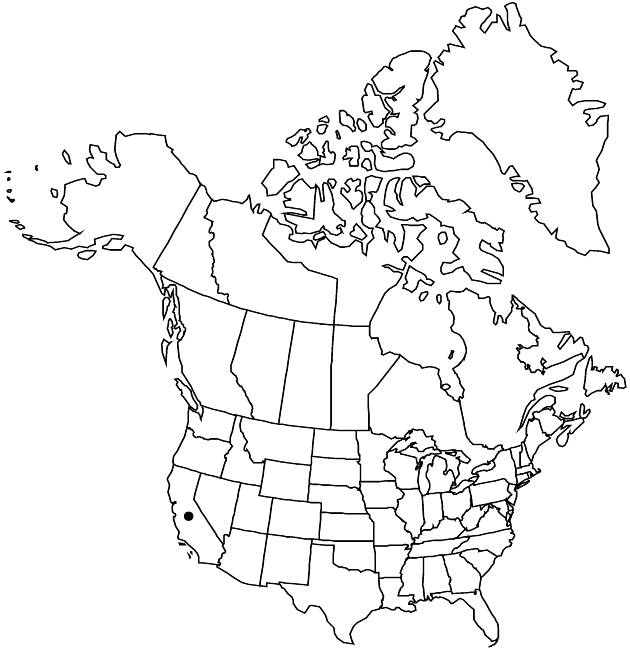Difference between revisions of "Holocarpha obconica"
Aliso 4: 111. 1958.
FNA>Volume Importer |
imported>Volume Importer |
||
| (6 intermediate revisions by 2 users not shown) | |||
| Line 7: | Line 7: | ||
|year=1958 | |year=1958 | ||
}} | }} | ||
| − | |basionyms={{Treatment/ID/ | + | |special_status={{Treatment/ID/Special_status |
| + | |code=E | ||
| + | |label=Endemic | ||
| + | }} | ||
| + | |basionyms={{Treatment/ID/Basionym | ||
|name=Hemizonia obconica | |name=Hemizonia obconica | ||
|authority=J. C. Clausen & D. D. Keck | |authority=J. C. Clausen & D. D. Keck | ||
| + | |rank=species | ||
| + | |publication_title=Madroño | ||
| + | |publication_place=3: 7. 1935 | ||
}} | }} | ||
|synonyms={{Treatment/ID/Synonym | |synonyms={{Treatment/ID/Synonym | ||
|name=Hemizonia vernalis | |name=Hemizonia vernalis | ||
|authority=D. D. Keck | |authority=D. D. Keck | ||
| − | }}{{Treatment/ID/Synonym | + | |rank=species |
| + | }} {{Treatment/ID/Synonym | ||
|name=Holocarpha obconica subsp. autumnalis | |name=Holocarpha obconica subsp. autumnalis | ||
|authority=D. D. Keck | |authority=D. D. Keck | ||
| + | |rank=subspecies | ||
}} | }} | ||
|hierarchy=Asteraceae;Asteraceae tribe Heliantheae;Asteraceae (tribe Heliantheae) subtribe Madiinae;Holocarpha;Holocarpha obconica | |hierarchy=Asteraceae;Asteraceae tribe Heliantheae;Asteraceae (tribe Heliantheae) subtribe Madiinae;Holocarpha;Holocarpha obconica | ||
| Line 32: | Line 41: | ||
|elevation=10–500 m | |elevation=10–500 m | ||
|distribution=Calif. | |distribution=Calif. | ||
| − | |discussion=<p>Holocarpha obconica ranges from the eastern San Francisco Bay area and northwest San Joaquin Valley to the Inner South Coast Ranges and is disjunct in western foothills of the southern Sierra Nevada. Often, H. obconica occurs with or near H. heermannii or H. virgata. Crossing studies have shown that different populations of H. obconica retain high interfertility; crosses to other species of Holocarpha have failed or yielded sterile hybrids (J. Clausen 1951).</p> | + | |discussion=<p><i>Holocarpha obconica</i> ranges from the eastern San Francisco Bay area and northwest San Joaquin Valley to the Inner South Coast Ranges and is disjunct in western foothills of the southern Sierra <i>Nevada</i>. Often, <i>H. obconica</i> occurs with or near <i>H. heermannii</i> or <i>H. virgata</i>. Crossing studies have shown that different populations of <i>H. obconica</i> retain high interfertility; crosses to other species of <i>Holocarpha</i> have failed or yielded sterile hybrids (J. Clausen 1951).</p> |
|tables= | |tables= | ||
|references= | |references= | ||
| Line 41: | Line 50: | ||
-->{{#Taxon: | -->{{#Taxon: | ||
name=Holocarpha obconica | name=Holocarpha obconica | ||
| − | |||
|authority=(J. C. Clausen & D. D. Keck) D. D. Keck | |authority=(J. C. Clausen & D. D. Keck) D. D. Keck | ||
|rank=species | |rank=species | ||
| Line 55: | Line 63: | ||
|publication title=Aliso | |publication title=Aliso | ||
|publication year=1958 | |publication year=1958 | ||
| − | |special status= | + | |special status=Endemic |
| − | |source xml=https:// | + | |source xml=https://bitbucket.org/aafc-mbb/fna-data-curation/src/2e0870ddd59836b60bcf96646a41e87ea5a5943a/coarse_grained_fna_xml/V19-20-21/V21_704.xml |
|tribe=Asteraceae tribe Heliantheae | |tribe=Asteraceae tribe Heliantheae | ||
|subtribe=Asteraceae (tribe Heliantheae) subtribe Madiinae | |subtribe=Asteraceae (tribe Heliantheae) subtribe Madiinae | ||
Latest revision as of 20:14, 5 November 2020
Plants 10–80(–120) cm; stems ± resinous distally (not notably stipitate-glandular). Heads in corymbiform or paniculiform arrays. Involucres ± obconic to ± globose. Phyllaries each bearing (0–)5–15(–20) gland-tipped processes and usually glabrous or minutely sessile- or stipitate-glandular (rarely ± hispid). Ray florets 4–9. Disc florets 11–21; anthers yellow to brownish. 2n = 12.
Phenology: Flowering Apr–Nov.
Habitat: Grasslands, savannas
Elevation: 10–500 m
Discussion
Holocarpha obconica ranges from the eastern San Francisco Bay area and northwest San Joaquin Valley to the Inner South Coast Ranges and is disjunct in western foothills of the southern Sierra Nevada. Often, H. obconica occurs with or near H. heermannii or H. virgata. Crossing studies have shown that different populations of H. obconica retain high interfertility; crosses to other species of Holocarpha have failed or yielded sterile hybrids (J. Clausen 1951).
Selected References
None.
